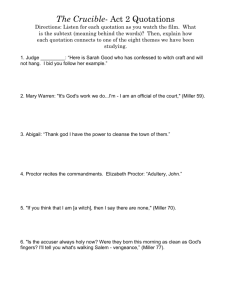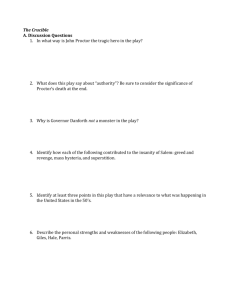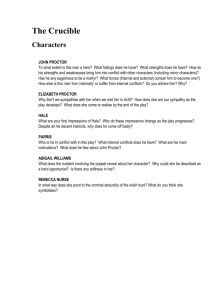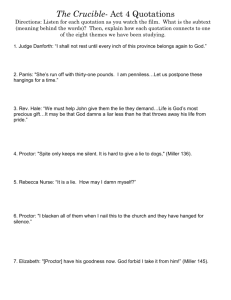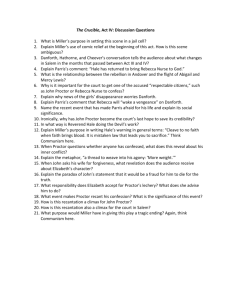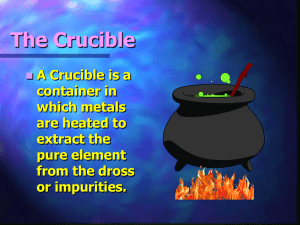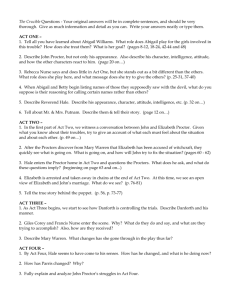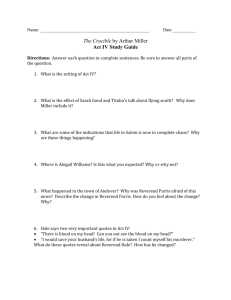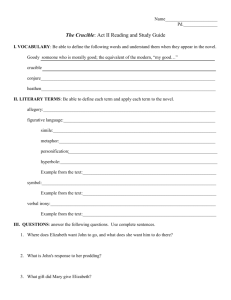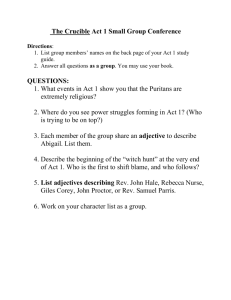Crucible Essay – Yuenho Wong
advertisement
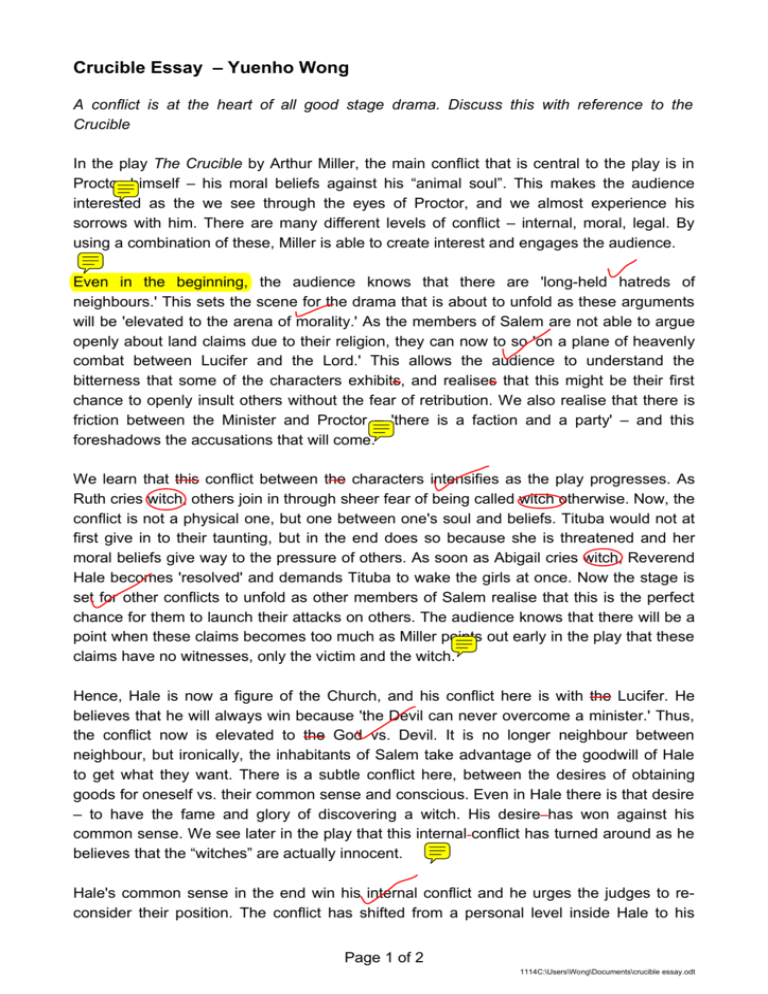
Crucible Essay – Yuenho Wong A conflict is at the heart of all good stage drama. Discuss this with reference to the Crucible In the play The Crucible by Arthur Miller, the main conflict that is central to the play is in Proctor himself – his moral beliefs against his “animal soul”. This makes the audience interested as the we see through the eyes of Proctor, and we almost experience his sorrows with him. There are many different levels of conflict – internal, moral, legal. By using a combination of these, Miller is able to create interest and engages the audience. Even in the beginning, the audience knows that there are 'long-held hatreds of neighbours.' This sets the scene for the drama that is about to unfold as these arguments will be 'elevated to the arena of morality.' As the members of Salem are not able to argue openly about land claims due to their religion, they can now to so 'on a plane of heavenly combat between Lucifer and the Lord.' This allows the audience to understand the bitterness that some of the characters exhibits, and realises that this might be their first chance to openly insult others without the fear of retribution. We also realise that there is friction between the Minister and Proctor – 'there is a faction and a party' – and this foreshadows the accusations that will come. We learn that this conflict between the characters intensifies as the play progresses. As Ruth cries witch, others join in through sheer fear of being called witch otherwise. Now, the conflict is not a physical one, but one between one's soul and beliefs. Tituba would not at first give in to their taunting, but in the end does so because she is threatened and her moral beliefs give way to the pressure of others. As soon as Abigail cries witch, Reverend Hale becomes 'resolved' and demands Tituba to wake the girls at once. Now the stage is set for other conflicts to unfold as other members of Salem realise that this is the perfect chance for them to launch their attacks on others. The audience knows that there will be a point when these claims becomes too much as Miller points out early in the play that these claims have no witnesses, only the victim and the witch. Hence, Hale is now a figure of the Church, and his conflict here is with the Lucifer. He believes that he will always win because 'the Devil can never overcome a minister.' Thus, the conflict now is elevated to the God vs. Devil. It is no longer neighbour between neighbour, but ironically, the inhabitants of Salem take advantage of the goodwill of Hale to get what they want. There is a subtle conflict here, between the desires of obtaining goods for oneself vs. their common sense and conscious. Even in Hale there is that desire – to have the fame and glory of discovering a witch. His desire has won against his common sense. We see later in the play that this internal conflict has turned around as he believes that the “witches” are actually innocent. Hale's common sense in the end win his internal conflict and he urges the judges to reconsider their position. The conflict has shifted from a personal level inside Hale to his Page 1 of 2 1114C:\Users\Wong\Documents\crucible essay.odt Crucible Essay – Yuenho Wong (and also Proctor's) struggle against authority. This has a bigger meaning as it is something that most of the audience can relate to and adds a personal touch to it. It interests the audience because they almost “want” Hale to win as he is portrayed as good and righteous man who has made a mistake. However, by letting the judges have their way, Miller suggests that “right” does not always win, and often, different perspectives can have different interpretations of “right”. This is shown by Judge Danforth's harsh words – 'who weeps for these, weeps for corruption!.' Miller invokes the audience to feel angered by his actions, as we have always viewed him as the protagonist. However, he also reminds us that Danforth is only doing his job and is not actually “wrong” as defined by the court. Proctor also has an internal conflict. His adultery with Abigail has shamed him for life, and in his mind he is not a good Christian despite the fact that the adultery is the only unChristian thing he has done. Thus, his internal conflict is between his conscious and his desire to keep a good name. At first, he is reluctant as he knows that if the tells everyone what he and Abigail has done, they would regard him as a low-life forever. On the other hand, if he doesn't, the whole town would be crazy with witchcraft. Thus, he debates this in his head and the audience realises that he is trapped between a rock and a hard place. We learn to sympathise and feel sorry for him as he is a good man underneath with a fatal flaw. This internal conflict inside Proctor allows Miller to manipulate the audience so that we take on the persona of Proctor. Interestingly, perhaps the most subtle, yet important, conflict is between John Proctor and his wife, Goody Proctor. Their quarrels have long plagued the minds of both, and there is a sense of coldness in their house. This conflict is perhaps the most common within any household, and yet it has to happen in Proctors'. Had this not occurred, they would not have any mistrust between them and John Proctor would be able to denounce Abigail without fearing the backlash of Goody Proctor. The most important part of the play of this conflict is when Danforth asks Goody Proctor whether she knew of her husband's adultery. Due to their cold relationship and their subtle conflict, she chooses to “protect” her husband and does not tell the truth. Even here there is a slight hint of internal conflict as she does not know that to do. Miller's subtlety placed conflict and dramatic irony here allows the audience to almost will Elizabeth to tell the truth, and it engages the audience. Thus, Miller is able to use a combination of legal, moral, and personal conflicts to engage the audience. This makes a good play because the audience will feel involved and also are able to see the characters' point of view through personal conflicts. The larger picture, however, will always be the moral issues that Miller has pointed out. In adding these larger conflicts, Miller hopes to tell us that sometimes it is the big picture that matters, and we would need to make sacrifices in order to achieve the goals we want. Page 2 of 2 1114C:\Users\Wong\Documents\crucible essay.odt
